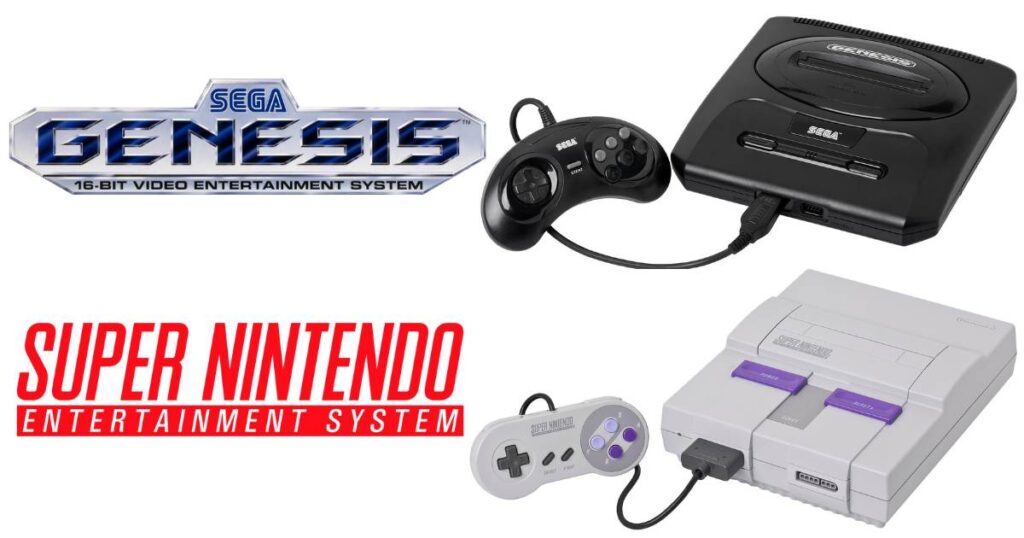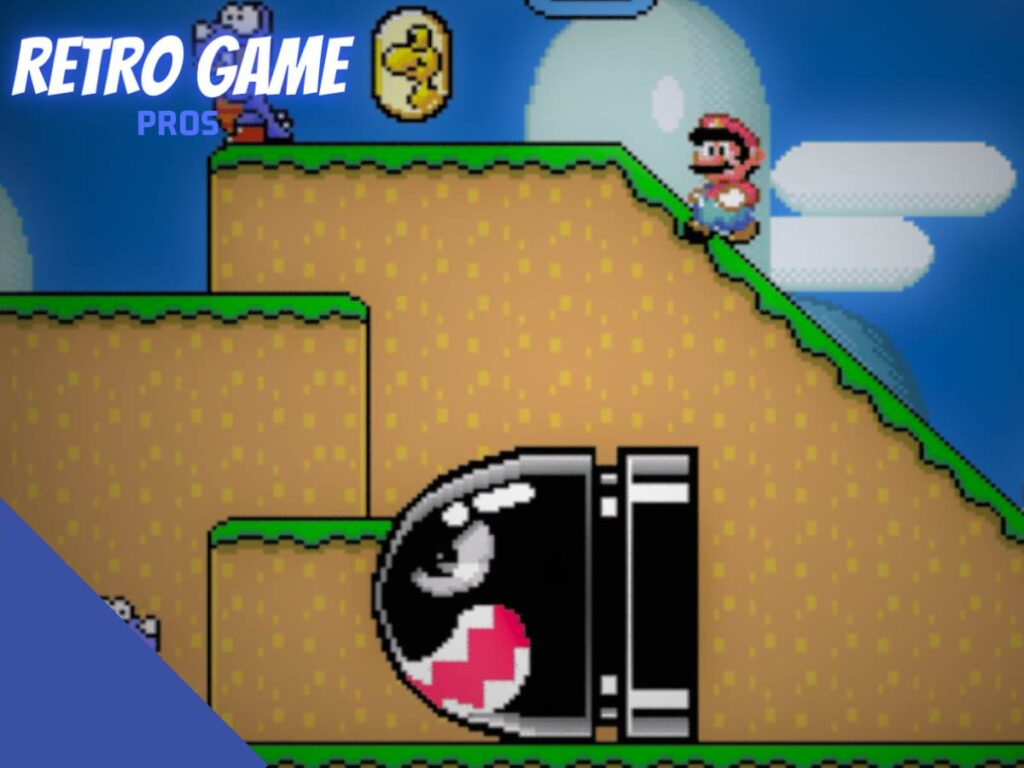Gaming has come a long way since its early days, and one significant milestone in its evolution was the advent of 16-bit consoles. These iconic gaming machines revolutionized the industry, ushering in an era of enhanced graphics, immersive sound, and captivating gameplay experiences. But what exactly does it mean for a console to be 16-bit?
A 16-bit console means that its CPU operates on 16-bit data at a time. It refers to the size of the data bus and the registers within the CPU, which affects how much data the CPU can process in a single instruction cycle.
Compared to earlier 8-bit consoles, 16-bit consoles had the capability to handle larger amounts of data more efficiently, enabling more complex graphics, better sound, and overall more advanced gameplay experiences. Some well-known examples of 16-bit consoles include the Sega Genesis (Mega Drive), Super Nintendo Entertainment System (SNES), and the Neo Geo. These consoles introduced significant advancements in gaming technology and paved the way for future generations of consoles.
What does 16-bit mean in video games?
Think of a 16-bit console like a highway with wider lanes compared to an 8-bit console. Just like wider lanes can accommodate more cars, a 16-bit console can handle more data at once. This means better graphics, more detailed game worlds, and richer sound compared to older consoles. It’s like upgrading from a small country road to a bustling freeway—it opens up a whole new level of possibilities for gaming!
Let’s compare two classic games from different console generations: “Super Mario Bros.” for the Nintendo Entertainment System (NES), an 8-bit console, and “Super Mario World” for the Super Nintendo Entertainment System (SNES), a 16-bit console.
Better graphics and richer sound versus 8-bit

- Super Mario Bros. (NES):
- Limited color palette: The NES could display a maximum of 56 colors at once.
- Simple sprites and backgrounds: Due to memory constraints, character sprites and backgrounds were relatively basic and lacked detail.
- Basic sound effects and music: The NES had limited capabilities for audio, resulting in simple melodies and sound effects.
.
- Super Mario World (SNES):
- Expanded color palette: The SNES could display up to 32,768 colors, allowing for more vibrant and detailed graphics.
- Intricate level design: With more memory available, developers created larger and more complex levels with hidden secrets and multiple paths.
- Enhanced sound and music: This SNES game had advanced audio capabilities when compared with Super Mario Bros. on the NES. It featured richer sound effects and music compositions with multiple layers and instruments.
In this comparison, Super Mario World on the SNES demonstrates the advantages of a 16-bit console over an 8-bit console. The game offered superior graphics, more sophisticated gameplay mechanics, and enhanced audio immersion, showcasing the potential of the newer hardware.
Comparison of 8-bit and 16-bit Console Architecture
The transition from 8-bit to 16-bit technology marked a significant leap forward in gaming technology and culture. In the late 1980s and early 1990s, advancements in semiconductor technology allowed for the development of more powerful processors and graphics capabilities, paving the way for the introduction of 16-bit consoles.
| Aspect | 8-bit Console | 16-bit Console |
|---|---|---|
| Data Width | 8 bits | 16 bits |
| Memory Addressing | Maximum 64 KB | Up to 4 GB |
| Graphics and Color Depth | Limited color palette (typically 256) | Thousands of colors simultaneously |
| Processing Power | Limited processing capabilities | More powerful processors |
| Sound Capabilities | Basic sound hardware | Enhanced sound with more channels and fidelity |
| Storage Medium | Cartridges | Floppy disks, CD-ROMs |
| Color Depth | Limited to 8-bit | 16-bit color depth |
| Processing Speed | Slower processing speed | Faster processing speed |
| Audio Channels | Fewer audio channels | More audio channels |
| Storage Capacity | Limited storage capacity | Larger storage capacity |
Bit Evolution: From 8-Bit & 16-bit console to Today’s Technological Marvels
Here’s a timeline from the era of 8-bit consoles to modern times, including notable consoles and advancements in gaming technology:
| Year | Console | Bit Rating | Notable Games / Features |
|---|---|---|---|
| 1983 | Nintendo Entertainment System (NES) | 8-bit | “Super Mario Bros.,” “The Legend of Zelda,” established the foundation for modern gaming. |
| 1985 | Sega Master System | 8-bit | “Sonic the Hedgehog,” Sega’s response to the NES. |
| 1987 | PC Engine / TurboGrafx-16 | 8/16-bit* | “Bonk’s Adventure,” early adoption of CD-ROM technology. |
| 1988 | Sega Mega Drive / Genesis | 16-bit | “Sonic the Hedgehog,” introduced blast processing and a strong rivalry with Nintendo. |
| 1990 | Super Nintendo Entertainment System (SNES) | 16-bit | “Super Mario World,” “The Legend of Zelda: A Link to the Past,” advanced graphics and sound. |
| 1994 | Sony PlayStation | 32-bit | “Final Fantasy VII,” first successful CD-based console, popularized 3D gaming. |
| 1996 | Nintendo 64 | 64-bit | “Super Mario 64,” introduced analog stick and 3D gaming, cartridge-based. |
| 2000 | Sony PlayStation 2 | 128-bit | “Grand Theft Auto: San Andreas,” best-selling console of all time, introduced DVD playback. |
| 2001 | Microsoft Xbox | 32/64-bit* | “Halo: Combat Evolved,” introduced Xbox Live online gaming service. |
| 2006 | Sony PlayStation 3 | 128-bit | “Uncharted 2: Among Thieves,” introduced Blu-ray, powerful Cell processor. |
| 2006 | Nintendo Wii | 8/32-bit* | “Wii Sports,” introduced motion controls, focused on casual and family-friendly gaming. |
| 2012 | Nintendo Wii U | 8/32-bit* | “Super Mario 3D World,” introduced GamePad controller with touchscreen. |
| 2013 | Sony PlayStation 4 | 64-bit | “The Last of Us Part II,” improved graphics, social features, and streaming capabilities. |
| 2013 | Microsoft Xbox One | 64-bit | “Halo 5: Guardians,” enhanced multimedia features, Kinect sensor (initially). |
| 2017 | Nintendo Switch | 64-bit | “The Legend of Zelda: Breath of the Wild,” hybrid console with portable and home modes. |
| 2020 | Sony PlayStation 5 | Variable | “Demon’s Souls (2020),” introduced SSD for faster loading times, ray tracing, and haptic feedback. |
| 2020 | Microsoft Xbox Series X/S | Variable | “Cyberpunk 2077,” focused on high-performance gaming, backward compatibility. |
| 2023 | Future Developments | Variable | Continuous advancements in hardware, VR, cloud gaming, and AI integration. |
*Note: The bit rating for certain consoles like the PC Engine/TurboGrafx-16, Sega Genesis/Mega Drive, Microsoft Xbox, Nintendo Wii, and Wii U is somewhat debated due to varying aspects of their hardware architecture. They are included in my table based on their historical significance and market positioning.
Origins of 16-Bit Gaming: Innovators and Visionaries
The concept of 16-bit gaming was not invented by a single individual but rather evolved through advancements in computer technology and video game consoles. However, several key figures and companies played significant roles in the development and popularization of 16-bit gaming.
- Ricoh: Ricoh Corporation, a Japanese electronics company, developed the 16-bit processor used in the Ricoh 5A22 chip, which powered the Super Nintendo Entertainment System (SNES). This chip was crucial in enabling the SNES to handle advanced graphics and gameplay compared to its 8-bit predecessors.
. - Gunter Ollmann and Andy Clitheroe: These two engineers at Sinclair Research Ltd. are credited with developing the 16-bit graphics chip used in the Sinclair QL computer, which was released in 1984. While the Sinclair QL was not primarily a gaming platform, its use of 16-bit technology contributed to the advancement of computing and gaming technology.
. - Nintendo and Sega: Nintendo and Sega were the major players in popularizing 16-bit gaming with the release of the Super Nintendo Entertainment System (SNES) and the Sega Mega Drive/Genesis, respectively. These consoles brought 16-bit gaming into the mainstream and introduced iconic franchises that defined the era.
While these individuals and companies were instrumental in the development and popularization of 16-bit gaming, it’s important to recognize that these technological advancements were pretty much the result of collaborative efforts and the cumulative contributions of many individuals and organizations within the industry.
Where and when did 16-bit games first get released

The first 16-bit console to be released was the PC Engine, known as the TurboGrafx-16 in North America. It was developed by NEC Home Electronics and Hudson Soft and was released in Japan on October 30, 1987. The TurboGrafx-16 was then released in North America on August 29, 1989. This marked the beginning of the 16-bit era in gaming consoles.
Along came the SNES and the Sega Genesis…
The SNES was released by Nintendo in Japan on November 21, 1990, and later in North America on August 23, 1991. Its release marked a significant advancement in gaming technology, boasting 16-bit graphics and sound that far surpassed its 8-bit predecessors. Similarly, the Sega Genesis, known as the Mega Drive in regions outside of North America, was released by Sega in Japan on October 29, 1988, and later in North America on August 14, 1989.
The release of the Super Nintendo Entertainment System (SNES) holds a special place in my gaming journey. I vividly remember the excitement surrounding its launch in 1990. As a young gamer, the SNES represented a quantum leap in gaming technology with its 16-bit graphics and immersive gameplay.
The day I brought home the SNES was unforgettable. From the moment I powered it on and played “Super Mario World,” I was hooked. The vibrant colors, detailed sprites, and memorable soundtracks transported me to fantastical worlds, sparking my imagination and fueling my passion for gaming.
The SNES wasn’t just a console to me; it was a gateway to unforgettable adventures and cherished memories spent with friends and family. Whether I was exploring the kingdom of Hyrule in “The Legend of Zelda: A Link to the Past” or racing through Rainbow Road in “Mario Kart,” the SNES provided endless hours of joy and excitement.
Even now, decades later, the SNES remains an integral part of my gaming collection, a timeless reminder of the magic of childhood and the power of video games to inspire, entertain, and bring people together.
Significance of 16-Bit Gaming: Shaping the Gaming Landscape
16-bit consoles, such as the Super Nintendo Entertainment System (SNES) and the Sega Genesis/Mega Drive, had a profound societal and cultural impact. These consoles not only revolutionized gaming but also became cultural phenomena that influenced popular culture in the 1990s and beyond. They were more than just gaming devices; they were gateways to imaginative worlds and shared experiences that captivated players of all ages.
16-bit technology enabled more immersive and complex gaming experiences that were not possible on 8-bit consoles. The increased processing power and memory capacity allowed developers to create larger game worlds, more detailed graphics, and more sophisticated gameplay mechanics.
Games like “The Legend of Zelda: A Link to the Past,” “Final Fantasy VI,” and “Sonic the Hedgehog” showcased the capabilities of 16-bit consoles, offering players expansive worlds to explore, deep storylines, and dynamic gameplay mechanics. These games pushed the boundaries of what was possible on 16-bit hardware and set new standards for gaming excellence.
16-bit Console Shaped Generation Y and Beyond…
The innovations introduced by 16-bit consoles continue to shape and influence gaming today. Many gameplay mechanics, design principles, and storytelling techniques pioneered during the 16-bit era are still prevalent in modern game development.
The emphasis on immersive storytelling, character development, and world-building seen in games like “The Legend of Zelda: A Link to the Past” and “Final Fantasy VI” laid the foundation for narrative-driven experiences in contemporary gaming. Additionally, the evolution of side-scrolling platformers, action-adventure games, and role-playing games during the 16-bit era established conventions and tropes that persist in modern game design.
The advancements in graphics, sound, and gameplay mechanics made possible by 16-bit technology set the stage for future innovations in gaming hardware and software. The lessons learned from the successes and failures of 16-bit consoles continue to inform the development of new technologies and gaming experiences in the industry.
Looking Ahead
As we look ahead to the future of gaming technology, it’s clear that the advancements of the 16-bit era continue to influence and shape the industry. While modern consoles now boast advanced graphics, virtual reality, and cloud gaming capabilities, the core principles of immersive gameplay, engaging storytelling, and technical innovation that were established during the 16-bit era remain relevant today.
As technology continues to evolve, we can expect to see further integration of artificial intelligence, augmented reality, and immersive gaming experiences that build upon the foundation laid by 16-bit consoles.
We at Retro Game Pros pros love 16-bit consoles. How about you? Are you a fan of 16-bit gaming? Share your thoughts and favorite memories in the comments below! Let’s celebrate the enduring legacy of these iconic consoles together.
